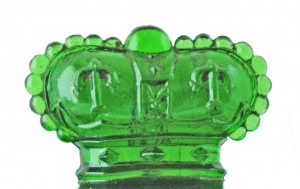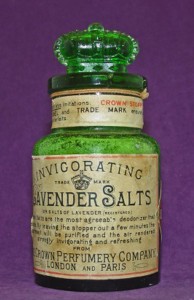
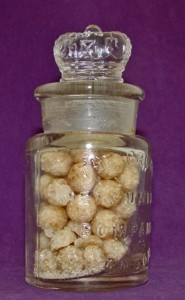
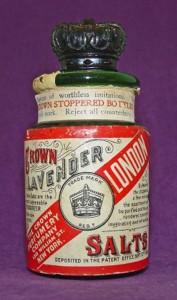
Occasionally, however, a fad crops out that is not altogether nonsensical, and is sometimes even decidedly useful. Such a one was on exhibition at Tiffany’s the other day, and as the fad is invariably under the wing of Dame Fashion, this one is sure to have a large popularity.
In itself it consists of nothing more than a handsome cut glass jar closed with a massive silver lid handsomely chased and designed, the whole only about double the size of a good library inkstand. But the young man who started to buy one for his sweetheart as a handsome pickle jar, would find himself at fault. The jar has other uses—hence the fad.
Since the Crown Perfumery company, of London, first brought out its now famous Lavender Salts the entire feminine world has come to look upon them not so much as a luxury as they are a luxurious necessity. Apart from their use in the boudoir, the exquisite perfume which these salts give off when opened in a room has brought them prominently forward as atmospheric perfumers. It is in recognition of this use that the jewelers have constructed the jars before mentioned, and no society woman now but has one of them filled with the delicately tinted salts on her drawing room table. This is by no means, however, an exclusively American fad, as we learn that the great jewelry houses of Paris and London also have the Lavender Salts jars, and that they are immensely popular over there. January 15, 1894 [6]
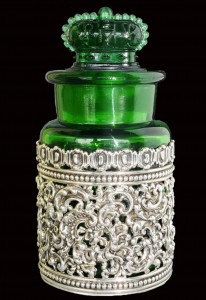
“Xmas 1892”
George Shiebler for Tiffany & Co.
4″ / 10.2 cm
What was the secret of Crown Lavender Salts that led the great jewelry houses of London, Paris and New York to proudly display jars of ammonia carbonate crystals in their upscale stores to entice wealthy society women to place open containers of these crystals in full view of their illustrious guests in their beautifully decorated homes? What was The Crown Perfumery Company’s secret to being the market leader of smelling salts for over a half century? And what was the big deal about smelling salts anyways?
The answers are found in the phrase “luxurious necessity.”
If our modern day medicine cabinets did not contain aspirin or non-aspirin pain relievers, we would turn to smelling salts, just as people did “back then,” before the first bottle of aspirin was sold in 1899. Headaches, fainting and breathing pungent air were maladies that smelling salts alleviated, revitalizing the stricken.
People had headaches, were dizzy and fainted because they wore layers upon layers upon layers of clothing year round; wore tightly laced corsets; had stuffy drawing rooms from heavy curtains being kept drawn over closed windows; had stale, smelly rooms due to poor sanitation inside and outside of the home.
Ammonia carbonate, the main ingredient of smelling salts, is primarily used to combat headaches, dizziness and fainting spells. It successfully works for these ailments as the ammonia fumes irritate the linings of the nose and lungs, causing a reflexive action to increase the rate of breathing which circulates a greater amount of oxygenated blood through the arteries, making us more alert. But the fumes are vile – so Thomson scented them with sweet smelling lavender! Lavender has a natural tranquilizing quality which reduces anxiety and agitation. Added to this was the fact that the lavender used by Crown was of the finest quality, produced to the highest standards – English lavender grown just south of London in Mitcham.
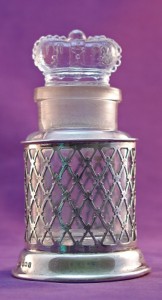
Crown Lavender Salts bottle in silver holder
Deakin & Francis, Birmingham, 1915
3.5″ / 9 cm
For Amelia Earhart, the famed aviatrix, smelling salts were a necessity. To avoid the fatigue caused by her ongoing sinus problems when flying, she brought along a small bottle of smelling salts to keep her alert. The Amelia Earhart Collection at Purdue University has a Crown Lavender Salts bottle “probably used by Earhart to stay awake during her 1932 solo flight across the Atlantic.” [7]
According to Charles E. Thomson, Crown Lavender Salts were sold in America and Invigorating Lavender Salts were sold in England and elsewhere around the world. Advertisements in England used the phrase “Crown Lavender Salts” while showing a bottle with a label for Invigorating Lavender Salts. Rather than using both titles, I use the most familiar term, Crown Lavender Salts, for convenience.
Although I have seen 1862 as the earliest date for Crown Lavender Salts in recent articles, this seems unrealistic. Had Crown Lavender Salts been in use since that date, Thomson would have been advertising his most important product. Thomson registered the trademark for Lavender Salts in the United States in 1887, with a statement that this name was in use since March 1, 1885. The earliest advertisement of Crown Lavender Salts which I have seen is January 15th, 1886 in an English magazine. After this date, there are many, many advertisements.
When William Sparks Thomson combined spirit of lavender with ammonia carbonate, he created a product that households needed, hospitals required and passengers traveling by carriage, rail or ship requested. It was an ingenious solution and an immediate success. Crown Lavender Salts became the principal product of The Crown Perfumery Company. By 1890, over 300,000 bottles were being sold annually. That number was raised to half a million bottles by 1892. The majority of advertisements for their high quality perfumes would have a reference to Crown Lavender Salts, thus providing instant name recognition and reputation for the perfume.
For the home, Crown Lavender Salts came in 1, 2, 3 and 4 oz. For hospital use, a large 8 oz. bottle was available. Green glass was by far the most common color, with a few examples in clear or brown glass. When the liquid component of the salts fell low in the bottle, Lavender Salts Essence was used to refill the bottle.
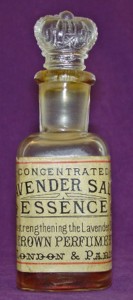
3.75″ / 9.6 cm
Medicinal items need not be bland or unobtrusive. Physicians needed Crown Lavender Salts for their patients’ illnesses to alleviate the odors of the sick room and hospital, rooms typically stuffy, musty and with not-so-fresh an atmosphere. One example of intertwining luxury with necessity is a large 4 oz. or 8 oz. bottle of Crown Lavender Salts in a silver holder. When the stopper was removed the room was continuously refreshed. Placing the salts in a silver holder would have added a psychological boost to the patient.
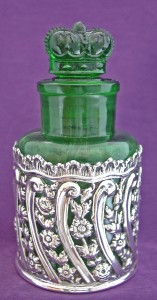
JDWF, Chester, 1901
5.5″ / 14 cm tall; 3″ / 7.6 cm diameter
Another example of intertwining luxury with necessity is an ebony walking cane with a silver hinged case hiding a 3” tall bottle. Close at hand, and within easy reach, such a walking cane would benefit the physician personally when he felt affected by the sights and smells of the hospital or sick room.
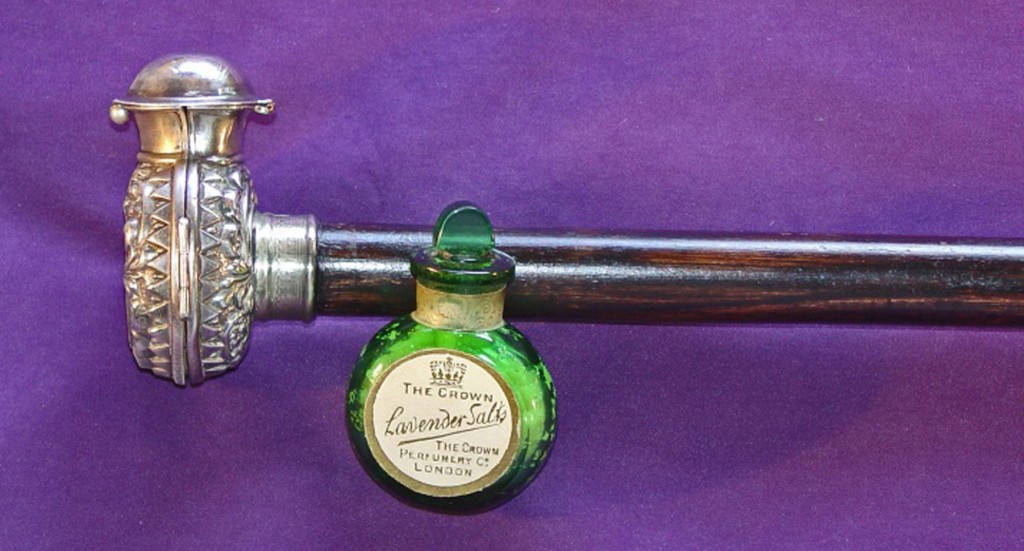
Cornelius Desormeaus Saunders & James Francis Hollings – Frank Shepherd, Birmingham, 1901
The bottle is 2.25 ” / 5.7 cm
To transform an everyday item into one of elegance only required Crown’s green glass salts bottle with its royal crown to be placed in ornate silver holders. These elegant items were proudly displayed in society’s sitting rooms and parlors. Dozens of designs, shapes and styles were produced by the silversmiths of London, Birmingham, Chester and New York. A few examples are shown in this chapter; more are shown in the chapter on Silversmiths.
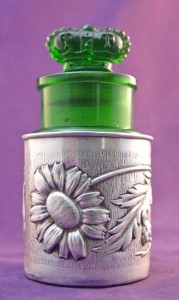
WHS, Birmingham, 1903
3.25″ / 8.2 cm
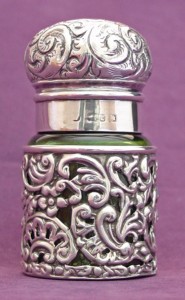
Deakin & Francis, Birmingham, 1899
4″ / 10.2 cm
The term “atmospheric perfumer” suited Crown Lavender Salts perfectly. Their bottles had a large opening which allowed the fragrance to flow freely throughout the room. The lovely silver holders graced any surface. Over time, cut crystal jars with heavy silver lids were available in the fine jewelry houses of New York, London and Paris.
![Vogue, November 15th, 1912 [8]](http://www.saltsscentsandsociety.com/wp-content/uploads/2016/02/033-1024x707.jpg)
Vogue, November 15th, 1912 [8]
These “large jars,” as shown above, were the direct result of one client’s request for the sickroom of an ill friend. A fashionably dressed woman walked into the New York store with her own glass jar and requested that it be filled with Crown Lavender Salts. Mrs. Mary H. Sanders, the American branch manager from 1907 to 1914, politely told the woman that the firm used their own containers. The woman replied that her dear friend was ill and would greatly benefit from the large jar of Crown Lavender Salts. Mrs. Sanders complied, sending the happy woman away carrying about two pints of Crown Lavender Salts. A few days later, an important druggist called asking for large glass containers filled with salts. Large glass jars were quickly found and Crown began filling orders. Later, the above hexagonal jar was designed for this specific purpose.
The Crown Perfumery Company had three lines for their celebrated smelling salts: Crown Lavender Salts; Crown Perfumed Salts (Crab Apple Blossoms, Matsukita, Verbena, Violette, White Lilac, Ylang-ylang and other fragrances) and Crown Cologne Salts.
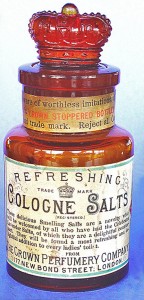
4″ / 10.2 cm
With the enormous variety of bottle shapes, sizes and ornamentation, people from every social stratum could display bottles of Crown Lavender Salts in their boudoirs and drawing rooms. It was a statement accessory when a sterling silver hinged case or a small ornate Opera bottle was removed from a reticule. They were a decorative accessory, colorized to harmonize with one’s boudoir. Yes, the liquids in the salts bottle were tinted various shades to color-coordinate with one’s very own color scheme.
Due to their success, many competitors infringed on Crown products — some innocently, some maliciously. The Crown Perfumery Company had patents for their inventions and trademarks for many of their products. Crown Lavender Salts and Crab Apple Blossoms were products unknown prior to Thomson’s creation. He produced them. He perfected them. He advertised them. He protected his rights to these products. Advertisements and labels warned consumers to “Beware of worthless imitations. None genuine unless in CROWN STOPPERED BOTTLES bearing our label and trade mark. Reject all Counterfeits.” The company also warned pharmacists against “cutting” or diluting the salts to achieve greater profits.
When a published report stated that a “chemist” had purchased a bottle of Crown Ambroline Lotion, examined it and found it to contain “wood alcohol,” The Crown Perfumery Company was justifiably upset. Wood alcohol is of such inferior quality that it was never used by the firm, not even as a rinsing agent. A reputable chemist was hired to examine an “anonymously” purchased bottle of Crown Ambroline Lotion and report the findings. The results found that only the finest spirits were used and no trace of wood alcohol was present in the bottle. An investigation by the firm later found that the bottle with the wood alcohol had been refilled with another brand of lotion. The barber had wanted his patrons to think they were receiving the very best, when in fact they were receiving a vastly inferior product. This was a malicious attempt at fraud.
[6] The Pharmaceutical Era. 15 January 1894, 89.
[7] “Earhart Smelling Salts.” earchives.lib.purdue.edu/cdm/ref/collection/earhart/id/34 16 August 2015.
[8] Vogue. Vogue Online. 15 November 1912, 106.
